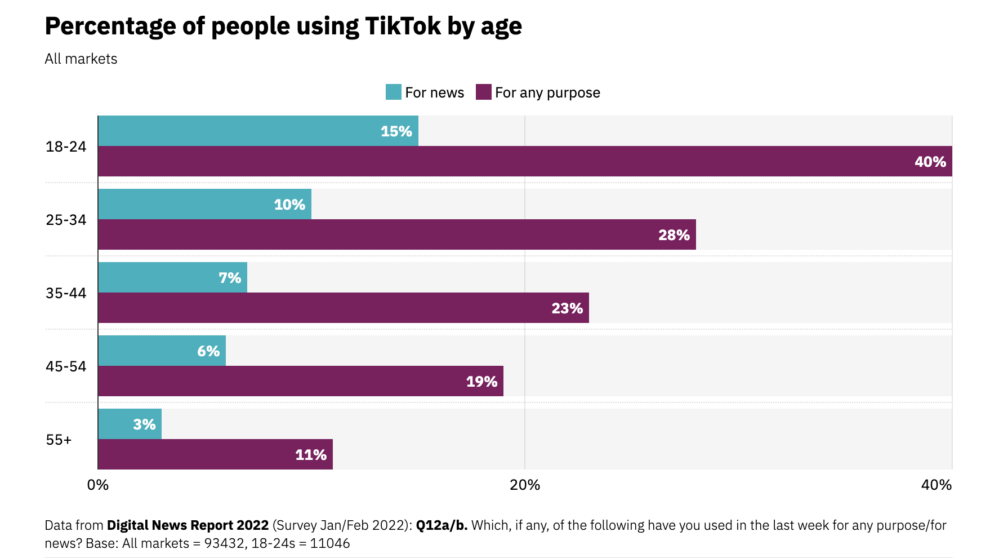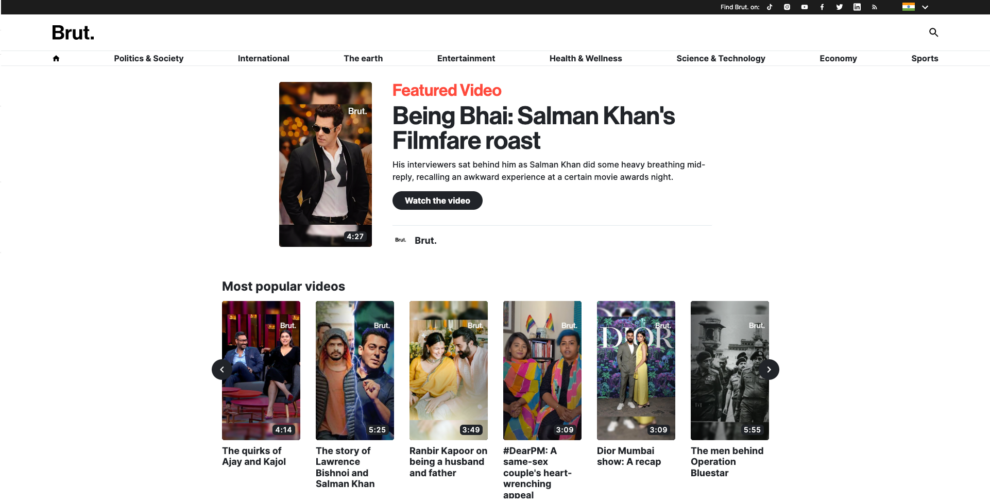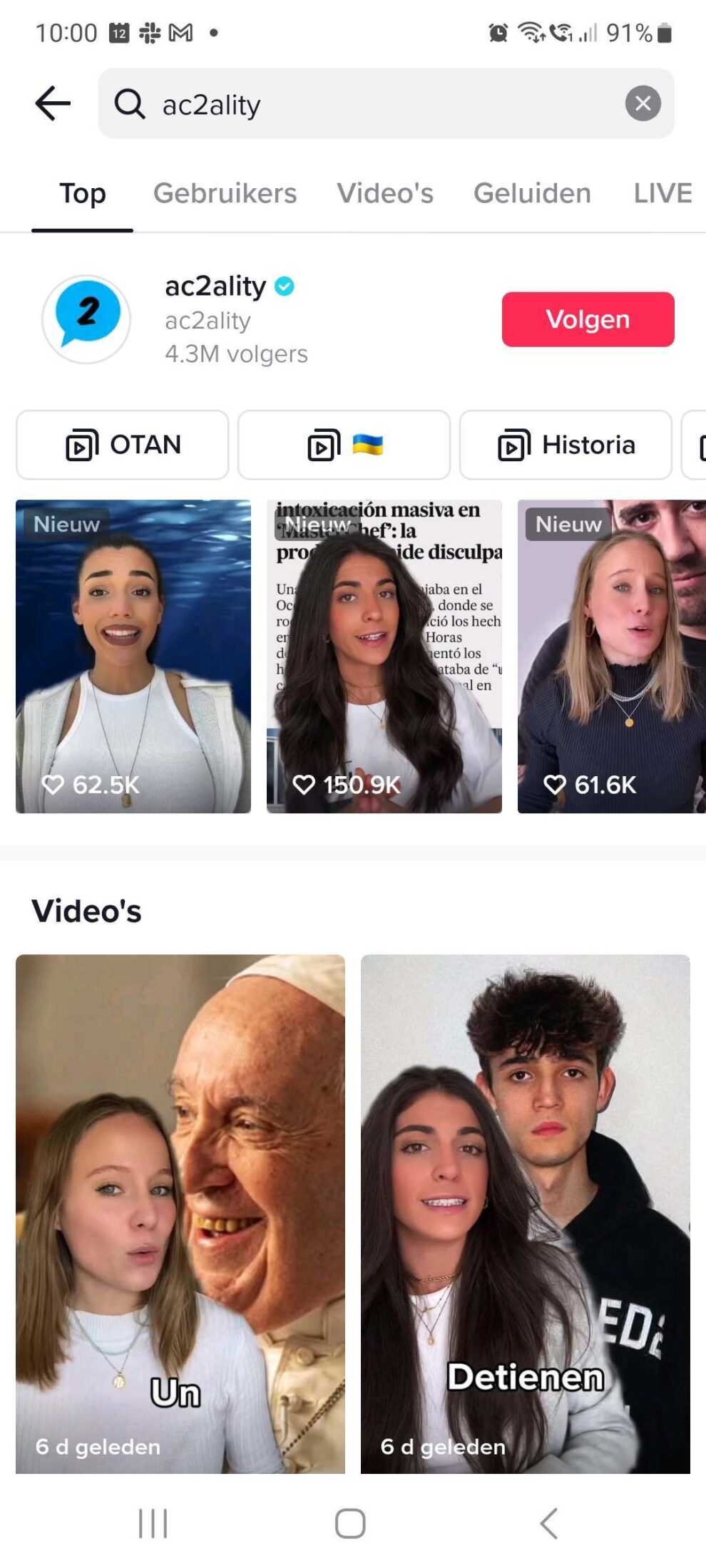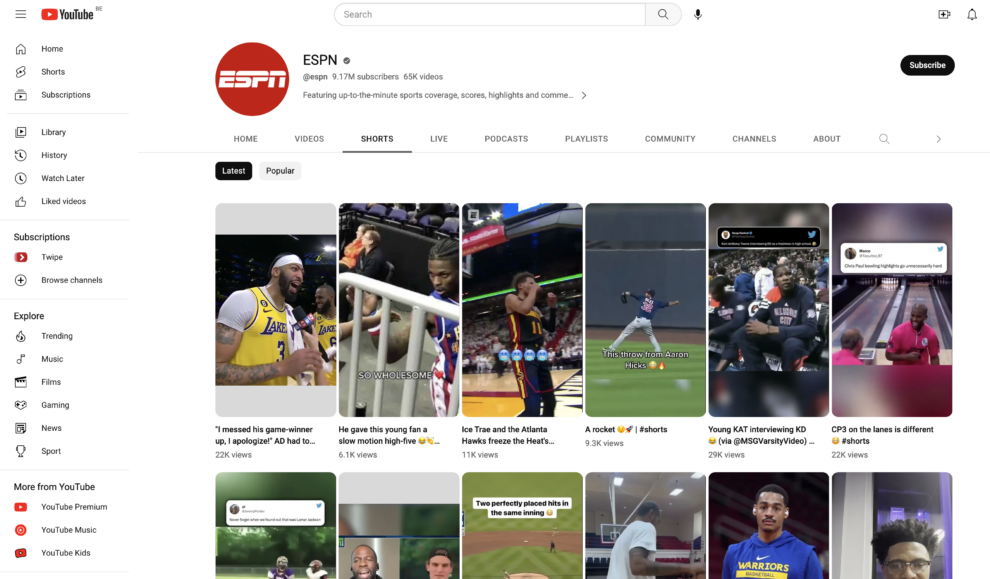In recent years there has been a surge of video content, with the medium penetrating all forms of life. Most pervasive recently is that of short-form videos. Between the likes of TikTok, Instagram Reels, and YouTube Shorts, short-form videos have become amongst the most advantageous ways to get in front of users’ eyes.
Among top news publishers, Reuters reports that 49% are now regularly publishing content on TikTok, with top adoption coming from the British, French, and Spanish news brands while Japanese and Italian outlets have been slower to adapt. With a growing amount of users looking towards TikTok and social media content for more than just entertainment, the adoption of news created using the short-form video format becomes more and more costly for news brands to ignore.

What is the draw of short-form video?
What exactly defines a “short-form video”? The definition is inconsistent across platforms. Google suggests that any video under 10 minutes is a short-form video while Instagram caps its Reels at 90 seconds. 64% of individuals are consuming content on multiple screens and platforms simultaneously. As a result, the quest for attention has never been more evasive. Short-form videos offer a bitesize and digestible format with the ability to hold attention keenly. Looking at TikTok, nothing has been more key to its success than its fabled algorithm. TikTok’s algorithm has become the stuff of legend, leaving users stupefied at the app’s uncanny ability to deliver tailored content that is certain to pique user’s interests.
Short-form videos often require low investment both from a viewer’s and from a creator’s perspective, with viewers not needing to expend a great deal of time on any single piece of content and creator’s being able to create mountains of content without much overhead. Further, from a creator’s perspective, the ability for short-form video to allow more content to be viewed by users in the same timespan as longer-form video offers more data points which can provide a more nuanced and complete view on who is in the audience. Looking towards the real world, how has news been able to adapt to this format and who has managed to thrive on these platforms?
1. Brut brings short-form video to their own platform, attending to audiences in 5 countries
Dominating as the most-viewed digital video publisher in India, a country with more than 60% of internet users watching short-form videos, Brut has taken hold of the market to deliver their content to a large audience across a variety of channels. Brut, a French company with content geared for India, the US, France, Mexico, and Spain, boasts 4.2 million followers on their French language TikTok channel and 300K followers on their English language Instagram page.
Brut India captures the attention of its audience; with 89% of its audience below 34 years of age, Mehak Kasbekar, Editor-in-Chief of Brut India, credits 3 elements for their success:
- the importance of knowing how to talk to Gen Z
- knowing how to effectively deliver this content in short-form video
- an intentional interest in quality journalism
While many would believe that in the world of short-form video it is quantity that prevails, Kasbekar notes that Brut India is putting out four videos a day compared to the 100-200 of competitors; yet, Brut India is still number one in their field.

Going beyond the use of existing platforms such as Instagram Reels or TikTok, Brut offers its own website to host their content along with a companion app. This app serves TikTok style short-form videos in tandem with five-to-fifteen-minute, multi-episode documentaries.
An ability to reclaim the views and content control from the major platform distributors could prove to be Brut’s most valuable asset as the monetisation of TikTok and YouTube Shorts underwhelm.
2. Betches Media uses short-form video to guide people to long-form podcasts
Betches Media is a a female-founded and led entertainment and media brand that has found success in vertical short-form video and is using it to continue its growth. Last year the brand saw a 40% increase in revenue. While short-form video has always been a priority for the brand, the proliferation of the medium has seen them pivot more head-on into the format. Betches Media has taken advantage of YouTube’s ability to host both short-form and long-form content. Betches Media has utilised YouTube Shorts as a way to break-up their long form podcasts into smaller bites in order to garner attention and lead users into interacting with full episodes of their “U Up?” podcast, yielding more than 7,000 subscribers organically in just a few months.
Is this story capturing your attention?
"(Required)" indicates required fields
3. Ac2ality captures the attention of Gen Z on TikTok
Launched in Spain in 2020, immediately after the country’s first COVID-19 lockdown, Ac2ality has become the continent’s second largest news publisher on TikTok, trailing only The Daily Mail. Built on bringing the news to a wide audience in a simple, visually appealing way, the small team has seen this significant growth by “translating the newspaper”. Lacking the big name behind them that usually follows legacy publishers when creating social media profiles, Ac2ality’s growth has been organic and is owed to their intelligence of the platform and audience that they are looking to capitalise on.


In an interview with Reuters, Ac2ality described their three formats which have spelled success on the platform: one minute explainers, 30 second news of the day briefs, and the use of trending video of audio samples to create news related segments.
Being successful on platforms such as TikTok mean both that a creator has the potential to get in front of the eyes of any user on the platform, regardless of if they can count themselves as a follower or not, but also that this opportunity exists for all other creators. As a result, you may only get the one chance to impress. Incorporating humour, attention capturing visuals, and catchy headlines is key to any success on the platform when creators often have only a fraction of a moment to capture the attention of a viewer.
Speaking to this effect, Gabriela Campbell, co-founder of Ac2ality will join the this year’s Twipe Digital Growth Summit in September.
4. LasVegas Review-Journal builds habit with daily short video at 7 AM
Beyond the ultra-short form videos, news publishers have harnessed short form video to meet the needs of their readers. The Las Vegas Review-Journal has seen continued success in recent years with their 7@7 news format. This format offers a seven-minute video broadcast at 7 a.m. and 7 p.m., covering everything from local news and politics, to weather and sports. This twice daily update released in a consistent format at a consistent time, allows for habit forming amongst subscribers, breeding loyal watchers who tune in regularly. Still more digestible than traditional half-hour news broadcasts in the US, this format bridges the gap between long-form and short-form video.
5. ESPN makes the most out of sport content’s great fit for short-form video
Arguably, no form of journalism is better suited for short-form content than that of sports journalism. Puskas worthy goals, web gems, and touchdowns only need seconds to be shown and SportsCenter’s Top 10 Plays format has seemed to be fit for the format, decades ahead of TikTok or YouTube Short’s inception.
ESPN seems to have found a balance on YouTube with short-form content driving scale and engaging their ecosystem while the longer-form content of pregame streams and podcasts drive retention and time spent. Grouping YouTube channels by topics has allowed users to subscribe to one source for all the content they are interested in, rather than being split across podcasts or formats. Having seen no cannibalism of audio-only podcast streams and video podcasts, ESPN lauds the YouTube Analytics for its ability to provide rich insights and granular data, something that surely is valuable, especially for smaller publishers looking to understand and grow their audience.

6. The Daily Mail leverages its vast array of content with segmentation
Capitalising on a strong Instagram following, The Daily Mail makes use of their Reels feature. Covering a wide array of content from celebrity gossip to on the street interviews with the public, The Daily Mail makes content interesting for social media and broad enough that it is able to land appeal with its wide audience. The Daily Mail has many facets to its profile, allowing certain entities, such as its sports account, to take on a life of its own with its own Instagram account and its own loyal following. Media brands with the ability to segment their brands into more specific niches allow themselves the opportunity to hone in on their audience and to deliver content to them on platforms they are already accessing for social media.
How can publishers take most advantage of this medium
The most pertinent question for many publishers is how to monetise their presence on short-form video platforms. These opportunities come in three ways. Firstly, is the straightforward monetisation from the platform directly. This strategy is arguably the most difficult as short-form video platforms prove to not be lucrative directly. TikTok, specifically, does not offer monetisation for companies while YouTube Shorts offers between $0.04 – $0.06 for every 1,000 views. A more fruitful venture may be to use the short-form mediums as an avenue for growth and visibility of a publisher’s brand, directing viewers to watch or read long-form content. Finally, branded content and advertising has the greatest opportunity for return on investment. eMarketer projects double-digit growth in the ad spending of short-form video, making it the fastest-growing ad segment in 2023
The frontier of short-form video is still being settled with YouTube Shorts only having been launched halfway through 2021. However, trends are already emerging as to how to make the most of these formats. First amongst these is embracing the format. News should be made easily understandable by an audience at a glance with the topic of the video being placed at the forefront of the video, as decisions on whether attention will be sustained are often made within a narrow timeframe. Publishers should not be afraid of adopting the trends that are popular on the platforms, whether that be including popular formats or memes within the delivery of the content. Finally, some content is better suited to short-form video than others, as has been seen by sports highlights and daily news wrap ups.
Did you find this story interesting?
"(Required)" indicates required fields
Other Blog Posts

Stay on top of the game
Join our community of industry leaders. Get insights, best practices, case studies, and access to our events.
"(Required)" indicates required fields

